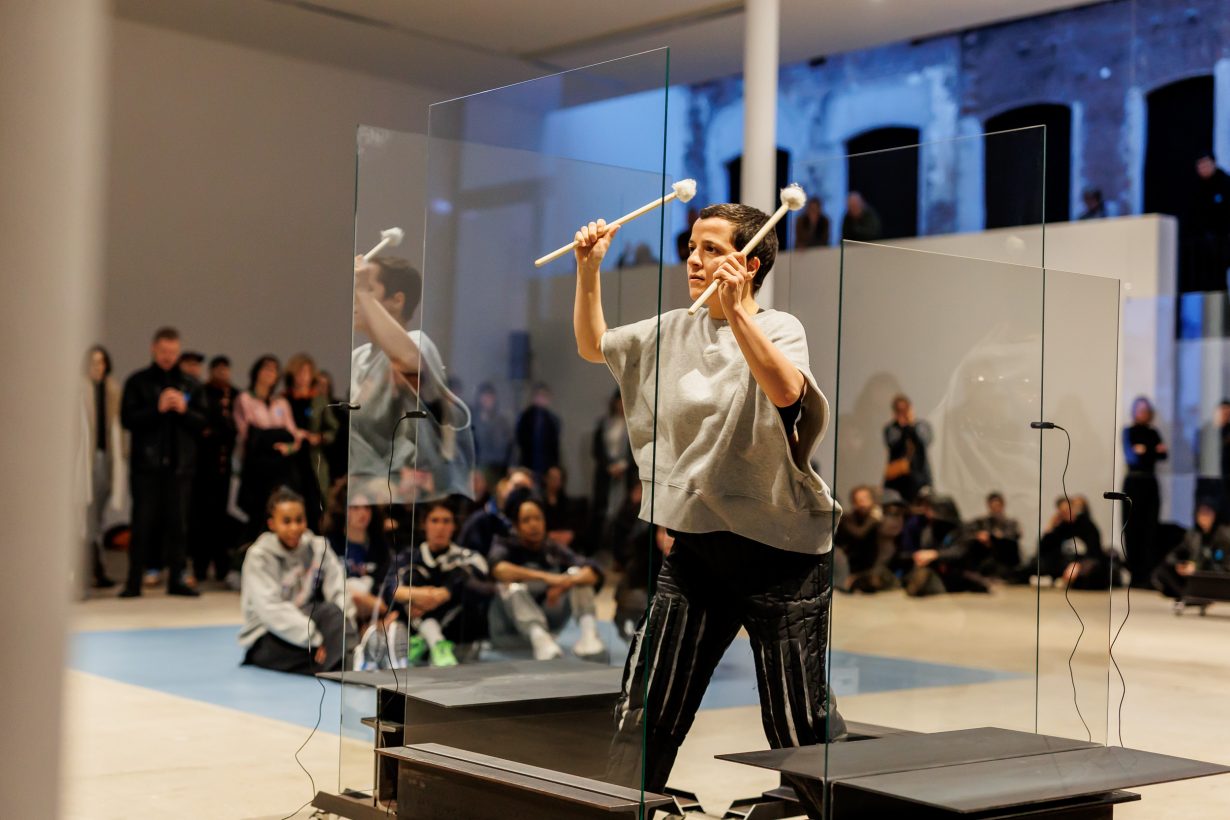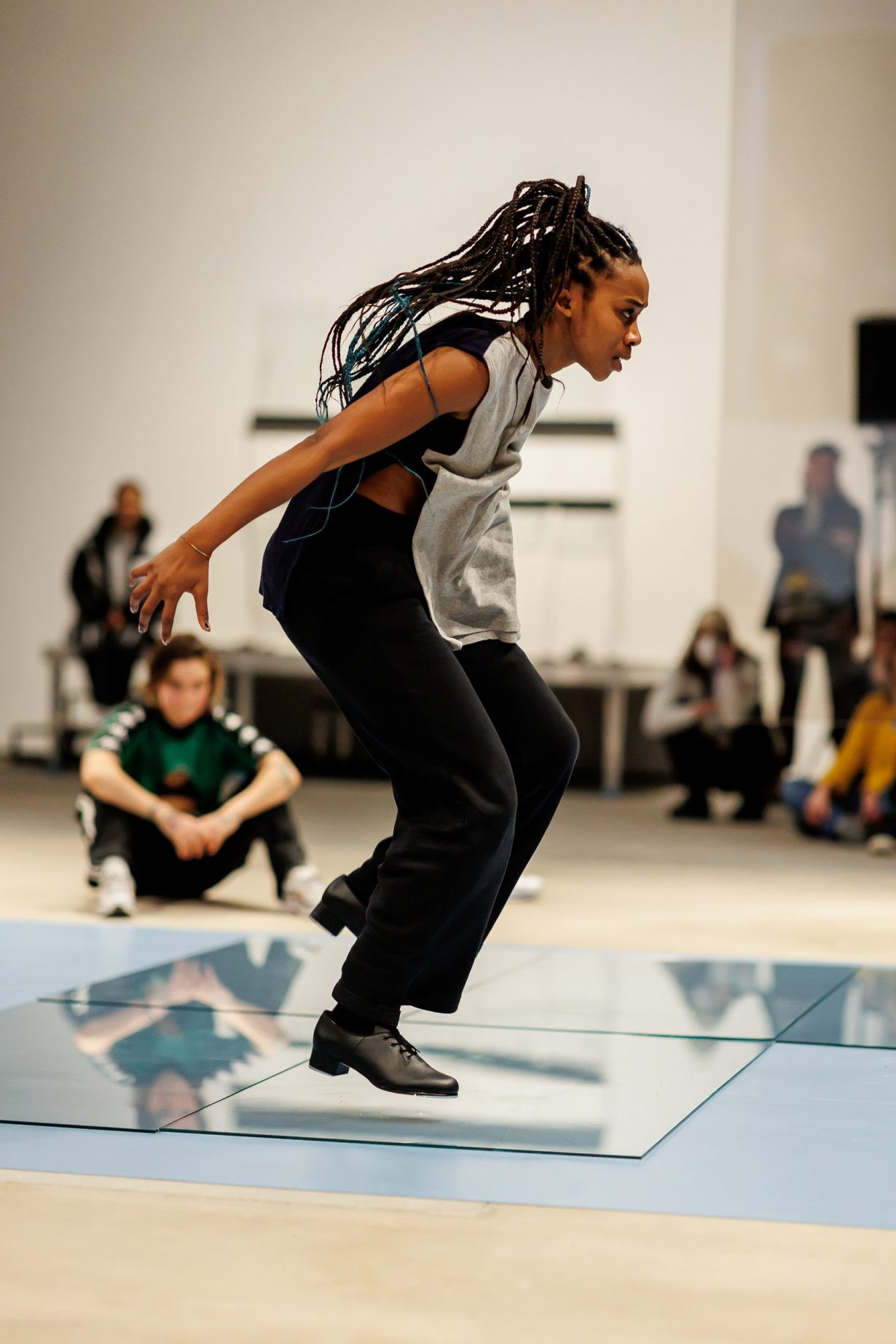The artist combines visual art, dance and performance to address how women are represented
Wearing a disparate assortment of upcycled sportswear – some of their trousers’ knee-panels are replaced with transparent plastic, mirroring the installation of rectangular sheets of glass that hang and stand around them – six women assume stereotypically feminine poses in unison. With an empowered, confrontational energy, they spread their legs, place their hands on the smalls of their backs and recline with heads tilted, as if sitting for portraits, in time to a rhythmic electronic score by DJ mobilegirl. Within moments, they’re marching militarily around, stamping, clapping, exhaling heavily like charging bulls and sidling up to the glass panels, fists raised like boxers. This is the opening phase of Crack Nerve Boogie Swerve (2019–), Amsterdam-based artist Alexis Blake’s German debut. Blake, 2021 winner of the Prix de Rome, combines visual art, dance and performance to address how bodies – those of women and queer people in particular – are represented. Crack Nerve…, reworked and developed here, explores questions of resistance and liberation in a visceral display of female power.
Alongside the aforementioned DJ tracks, there’s also a score of low-frequency sounds created by researcher Stefanie Egedy, one of a team of contributing sound artists. Issuing from subwoofers, these blasts of sonic power impose a physical pressure on the audience’s bodies: I feel as if my internal organs are contracting, my head placed in a tightening anvil. The glass sheets shudder, and the whole room vibrates perilously. The sound, in this context, might be considered as both an oppressive entity and an agent for breaking out of preexisting structures. The installation the dancers inhabit is less oppressive, however. According to the performance text, Blake intends for the panels to have agency. (Reading this recalls Czech choreographer Věra Ondrašíková’s Witness, 2021, in which dark-clothed dancers manipulate two leafless trees; as the performers disappear into the darkness, the swirling branches appear alive.) The glass in Crack Nerve…, however, is at the performers’ mercy. A suspended pane is mercilessly attacked with a hammer at the outset, shattering, while those mounted on rolling steel structures depend on human manipulation to move around. Even when they confine the project’s percussionist Sofia Borges, who pounds them with drumsticks, the stakes don’t feel that high: she’s working herself into an artistic trance rather than a state of claustrophobic panic or rabble-rousing defiance. It’s also clear she could escape her imprisonment by rolling them away at any point.

The glass’s presence, nevertheless, creates other visual metaphors that illuminate Blake’s themes. Often vanishing due to its transparency, it seemingly alludes to the covert yet omnipresent reality of those barriers faced by many social groups. At one point, two performers attach suction cups to raise a sheet of glass above their heads – a physical if literalist representation of the ‘glass ceiling’ perhaps? – before lowering it horizontally and pulsing it repeatedly towards the audience like a riot shield. At other times the dancers don’t interact with the glass, pulling focus instead to the varying styles they perform. Ranging from hip-hop and voguing to contemporary dance, ballet and Afro-fusion, these genres, as Blake asserts in the programme note, arose from challenging historical contexts and are well known for their potential for protest and resistance.

Towards the end, the dancers position five glass panels in an asymmetric configuration before systematically cracking every last one. One performer dons metal-plated shoes for a hunchbacked, defiant tap solo on the sheets; another, sporting crampons, jumps up and down on them. It’s unclear, though, what message should be taken away from Crack Nerve… Without a clear ‘oppressor’, the dancers’ performances feel unspecific, the literal imagery they conjure somewhat surface-level as a result. This said, the simplicity of a cast of six powerful female performers executing increasingly hostile choreography interestingly frames destruction as cathartic and hopeful, juxtaposing femininity and violence, confronting gender stereotypes in the process. It’s reminiscent of Pipilotti Rist’s Ever Is All Over (1997), which featured a video of the artist, dressed in a summer dress and red high heels, grinning as she systematically smashes car windows on the street with a large floral sculpture.
The dancers’ final celebration of conquering the glass panels, suggesting their destruction is symbolic of triumph, also activates a surprising degree of empathy for these inanimate objects. In context, the glass feels more oppressed than oppressor, the violence it endures pointing to the duality of fragility and resilience. No matter what the panels go through, they never shatter completely, keeping their form, just like those groups and individuals who keep going despite the barriers they are forced to break down. Perhaps, when Blake talks about imbuing the glass with agency, this emotional and empathetic activation is what she means.
Crack Nerve Boogie Swerve at KW Institute for Contemporary Art, Berlin, 27–29 January 2023
